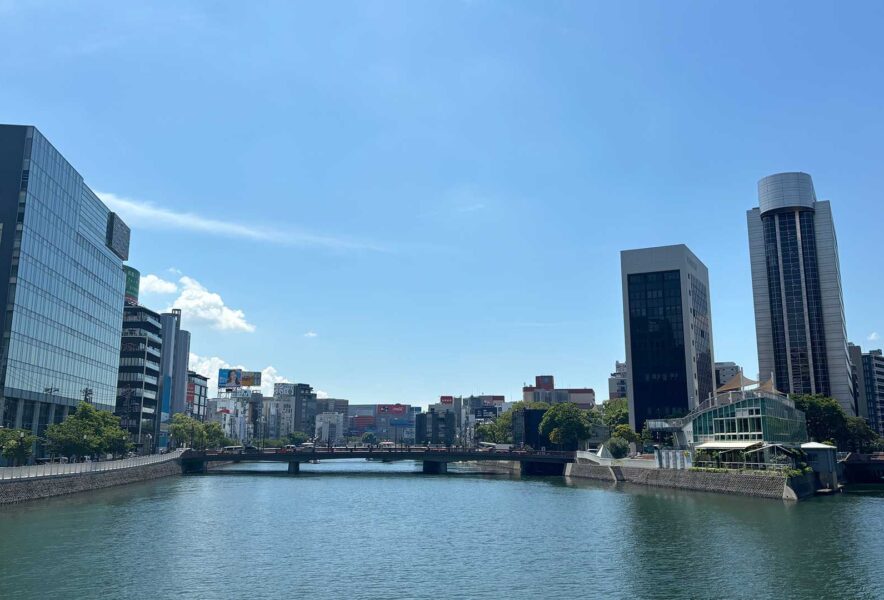Would you like to take a stroll through the streets of Hakata, a city full of historical atmosphere? This course starts from Gion Station and takes you to Hakata’s historical and cultural spots such as Hakata Machiya Furusato Kan, Kushida Shrine, and Fukuoka Asian Museum. Along the 3-kilometer walking route, visitors will enjoy the diverse charms of Hakata, passing historic temples, traditional shopping streets, beautiful gardens, and modern buildings, as well as Hakata’s unique culinary culture. Discover the charms of Fukuoka as you catch a glimpse of local life.
- Introduction
- Tenjin, Fukuoka City, Old Town, Hakata’s Gion Station Area Enjoyable Stroll Course Start
- A.Gion Station Important traffic point
- B.Hakata Machiya Furusato-kan (Hakata Machiya Furusato-kan) Travel back in time to the old days in Hakata.
- C.Kushida jinja Shrine Guardian God of Hakata
- D.Fukuoka Asian Art Museum Contemporary art in the heart of Tenjin
- E.Fukuoka Akarenga Bunka Kan, the cultural center- Important cultural property designed by Kingo Tatsuno
- F.Guided tours of the former Fukuoka Kihinkan are recommended.
- G.Fukuhaku Deai Bridge Bridge connecting two towns
- H.Gion Station
- Fukuoka Stroll A review of a fun walk around Gion Station in Hakata
- Fukuoka Stroll Enjoy a walk around Gion Station in Hakata Recommended Stories Nearby
Introduction
Outline of Fukuoka City and Purpose of City Walk
Fukuoka City is known as the gateway to the Kyushu region, a city that combines a rich history with modern charm. In ancient times, the city was known as “Hakata” and flourished as a center of trade and cultural exchange. Today, while the city still retains a strong sense of historical landmarks and traditional culture, it has also developed into a hub for business and tourism. Fukuoka City offers a wide variety of attractions, with an abundance of gourmet food, shopping, and cultural facilities.
The purpose of this city walk is to learn about and savor the culture and history of Fukuoka City in a short time. Within a limited amount of time, you can efficiently visit major tourist attractions and experience Fukuoka’s rich cultural heritage. Here are some routes that will allow you to fully experience the essence of Fukuoka City even in the limited time before your flight@.
Overall strolling route and time required
This city stroll route is a 3-kilometer course that takes visitors on foot to the major tourist attractions in Fukuoka City. The time required on foot is estimated to be approximately 2 to 3 hours. Please adjust the time spent at each spot and the pace of your visit accordingly.
Route Details
A.Gion Station Start
Convenient transportation, convenient as a base for sightseeing
↓ 300m
B.Hakata Machiya Furusato Kan
A facility that recreates traditional Fukuoka machiya houses and introduces the history and culture of Hakata
↓ 50m
C.Kushida Jinja Shrine
The chief Shinto shrine of Hakata, famous for festivals such as Hakata Gion Yamakasa
↓ 450m
D.Fukuoka Asian Art Museum
Unique art museum exhibiting mainly contemporary art from Asian countries.
↓ 550m
E.Fukuoka City Red Brick Cultural Center
Historic building built in the Meiji era and can be rented as a café or meeting room.
↓ 350m
F.Former Fukuoka Prefectural Public Hall Guest House
A typical Western-style building from the Meiji period, open to the public along with a beautiful garden.
↓ 150m
G.Fukuhaku Deai Bridge
A beautiful bridge over the Naka River, a spot where you can enjoy a panoramic view of the Fukuoka City landscape.
↓ 1km
H.Gion Station Goal
Back to the train station where the traffic is good, and that’s the end of today’s walk!
This route allows you to visit Fukuoka City’s major tourist attractions in a short time. Experience Fukuoka’s diverse culture as you tour historical buildings, shrines, and museums. Let’s take a look at the details of each spot in turn.
Tenjin, Fukuoka City, Old Town, Hakata’s Gion Station Area Enjoyable Stroll Course Start
A.Gion Station Important traffic point
Introduction of Gion Station
Gion Station is located in Hakata Ward, Fukuoka City, and is the transportation hub of the Hakata area, with convenient access to JR Kyushu’s conventional and Shinkansen lines and to Fukuoka Airport. Commercial facilities and tourist attractions are concentrated in the surrounding area, making it a bustling center of Hakata.
Gion Station is also a station on the Fukuoka City Subway Airport Line and is located in the center of the Hakata area. It is only one stop away from Hakata Station, making it a very convenient base for sightseeing. The area surrounding the station is a collection of historical sites and cultural facilities, making it a great starting point for experiencing the attractions of Fukuoka City.
Starting from Gion Station, there are many historical and cultural spots in the surrounding area. This area, which can be toured efficiently in a short time, is ideal for experiencing the diverse attractions of Fukuoka City. Next, let’s take a look at the Hakata Machiya Furusato Museum in detail.
B.Hakata Machiya Furusato-kan (Hakata Machiya Furusato-kan) Travel back in time to the old days in Hakata.
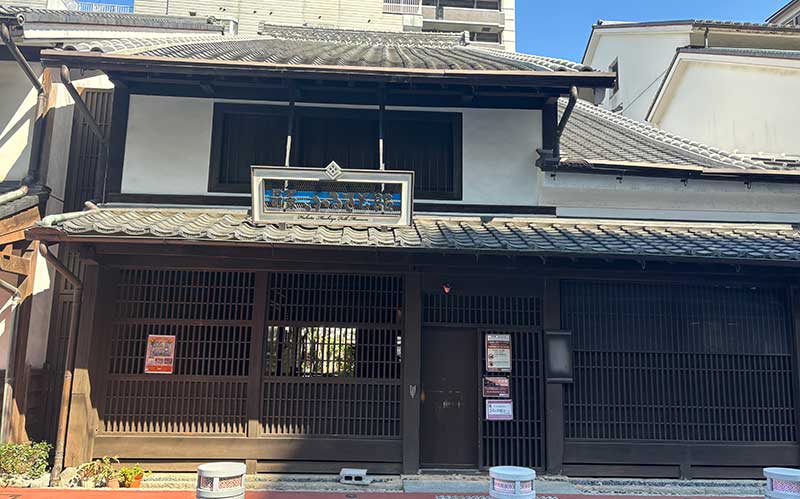
History and Role of Hakata Machiya Furusato Kan
Hakata Machiya Furusato-kan is a facility that recreates Hakata machiya houses from the Meiji and Taisho periods, located in Reisen-cho, Hakata-ku, Fukuoka City. Inside the museum, visitors can experience the historical lifestyle and culture of Hakata through exhibits that faithfully reproduce the lifestyle and machiya structure of the time.
Highlights of the Museum
1. Restoration of townhouses
The main part of the Hakata Machiya Furusato Kan is a faithful reproduction of a traditional Hakata townhouse. The building is divided into the residential and retail sections of a merchant house, reproducing the lifestyle of the period as it was in those days. This allows visitors to feel the real life of a merchant family in Hakata during the Meiji and Taisho periods.
Dwelling unit (esp. in a residential area)
The interior features a living room with tatami mats, a kitchen, and a bedroom, all of which remind us of life in those days. Every detail has been carefully reproduced, allowing visitors to feel the breath of life in those days.
Store portion
The store portion of a Hakata merchant’s house has also been reproduced, with merchandise from the period on display in the storefront. The fascinating exhibit offers a glimpse into the lively daily lives of merchants.
2. Exhibition room
In addition to a reproduction of a townhouse, the Hakata Machiya Furusato Kan has an exhibition room with materials on the history and culture of Hakata. Here, various exhibits on the history of Hakata’s development, festivals, crafts, and more are on display.
Hakata Gion Yamakasa exhibition
Don’t miss the Hakata Gion Yamakasa exhibit, a symbol of summer in Hakata. The history of the festival, how Yamakasa is made, and episodes related to the festival are introduced. Miniature models and video materials are also available, allowing visitors to feel the power and charm of the festival.
Hakata textile exhibition
Hakata-ori is a traditional textile of Hakata, and its beauty and technique are recognized worldwide. In the exhibition room, visitors can learn about the production process and history of Hakata-ori, as well as view actual products.


Introduction of local crafts and traditional culture
The Hakata Machiya Furusato Kan also showcases traditional Hakata crafts and culture. There are many exhibits that showcase the skills and cultural traditions of local craftsmen.
Hakata textiles
Hakataori is a well-known traditional Hakata textile craft with a history dating back to the Kamakura period (1185-1333). It is characterized by its fine, beautiful patterns and strong texture, and is used for obis and accessories. Demonstrations and workshops on Hakata-ori textiles are held at the museum, allowing visitors to experience weaving for themselves.
Hakata doll
Hakata dolls are traditional Hakata pottery, characterized by their delicate expressions and colors. Inside the museum, visitors can view exhibits that introduce the process of making Hakata dolls, as well as view actual pieces. Hakata dolls have long been highly regarded both in Japan and abroad, and are a craft that represents Fukuoka’s culture.
Local Festivals and Events
Hakata is also known as a region rich in festivals and events. Various events are held throughout the year, including Hakata Gion Yamakasa and Hakata Dontaku. The museum exhibits materials and videos related to these festivals and events, allowing visitors to experience the vibrant culture of Hakata.

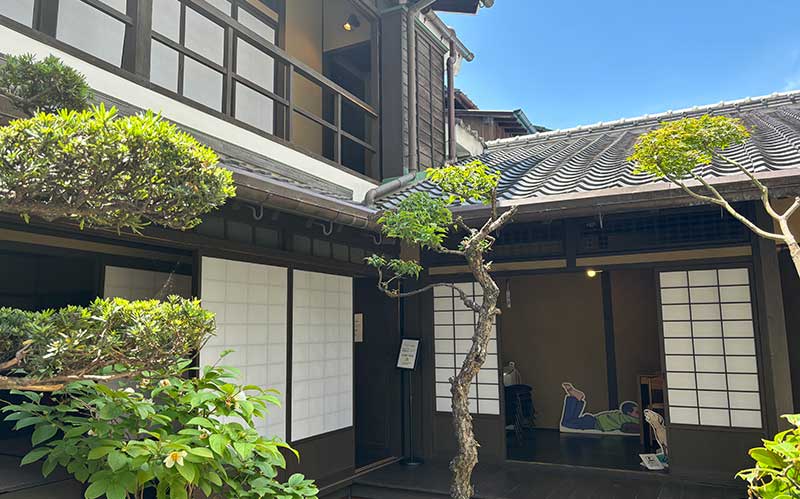
Hakata Machiya Furusato-kan Access
Address: 6-10 Reizumi-cho, Hakata-ku
tel/fax:092-281-7761
Hours: 10:00~18:00 from September to June (admission until 17:30), 9:00 in August
Closed on the 4th Monday of the month (or the following weekday if the Monday is a national holiday) and December 29-31
Admission: 200 yen for the exhibition building only (free for junior high school students and younger)
Official Website:Click here
The Hakata Machiya Furusato Kan is a valuable facility for visitors to gain a deeper understanding of Hakata’s history and culture. Visitors can fully experience the charm of Hakata through the reproduction and exhibition of machiya houses from the Meiji and Taisho eras, as well as traditional handicrafts such as Hakata Gion Yamakasa and Hakata textiles. Next, let’s take a closer look at Kushida Shrine.
C.Kushida jinja Shrine Guardian God of Hakata

History and Origin of Kushida jinja Shrine
Kushida jinja Shrine has a long history as the general guardian of Hakata. It was founded in 757 (the first year of Tempyo-Hoji) and has been revered as the guardian deity of Hakata. Kushida Shrine enshrines Susano no Mikoto, Ohatanushi no Mikoto, and Amaterasu no Mikami as its main deities, and is believed to bring many benefits such as protection from bad luck, prosperity in business, and safety in the home.
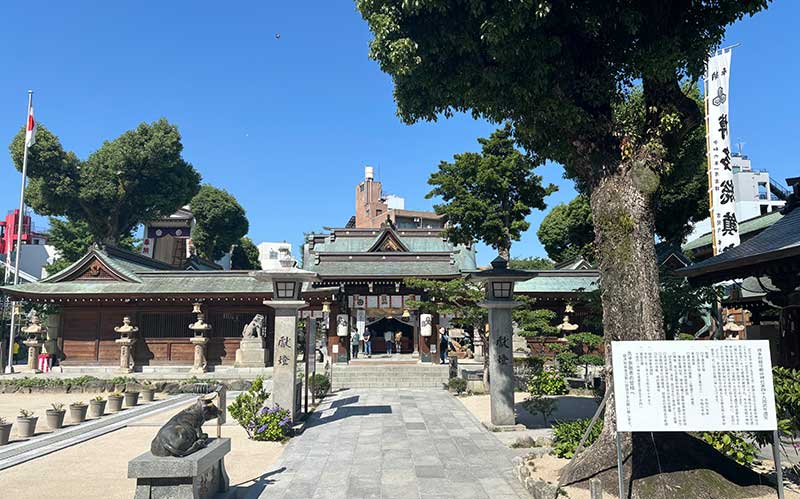
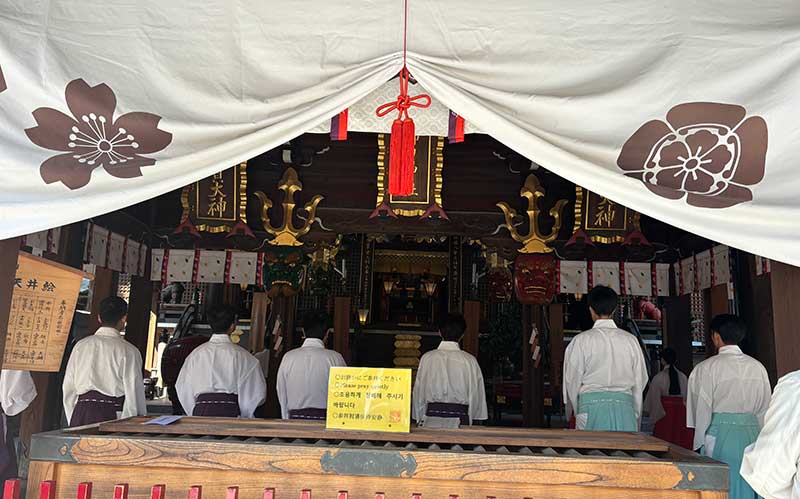
Places to visit in the precincts
- Rou-mon
The tower gate at the entrance of Kushida-jinja Shrine is a magnificent gate with magnificent carvings. It is also the starting point of a visit to the shrine, where decorative Yamakasa of the Hakata Gion Yamakasa festival are on display, giving visitors a sense of the festive atmosphere of the festival.
2. Main Shrine
The main hall, the focal point of the shrine, is built in a magnificent architectural style and is impressive for its beautiful decoration and serene atmosphere. Worshippers can place their hands together here and pray in silence.
3. Otafuku mask
Within the shrine grounds, there is a giant Otafuku mask. It is said that if you pass through it, you will be protected from evil and receive good fortune. The Otafuku mask is a symbol of Fukuoka, and is a popular photo spot for many visitors.
4. Ebisu Statue
Another highlight is the statue of Ebisu, known as the god of prosperity in business. You can pray for prosperity and success in business by joining your hands together in front of the statue.
The appeal of festivals and events
Kushida Jinja Shrine hosts various festivals and events throughout the year, attracting many people.
1. Hakata Gion Yamakasa
Kushida Jinja Shrine is most famous for the Hakata Gion Yamakasa, held every July. This festival has a history of over 700 years and is a major event that symbolizes summer in Fukuoka. The climax of the festival, the Oiyama, sees decorated Yamakasa floats race through the city, starting from Kushida Shrine. The dynamic spectacle and excitement of the festival are sure to be an unforgettable experience once you’ve seen it.
2. Kushida Jinja Shrine Setsubun Festival
The Kushida Jinja Shrine Setsubun Festival is held in February, and includes bean-throwing and warding off evil spirits. Many worshippers come to the shrine to bring good fortune, creating a lively atmosphere. At the shrine, you can enjoy a traditional event where people wearing demon masks throw beans to ward off evil spirits.
3. Kushida Jinja Shrine Autumn Festival
In autumn, the Kushida Jinja Shrine Autumn Festival is held. This festival is a fun event that brings together local people and features Shinto rituals to pray for a good harvest and traditional local performing arts. Along with the beautiful autumn scenery, you can experience traditional culture.

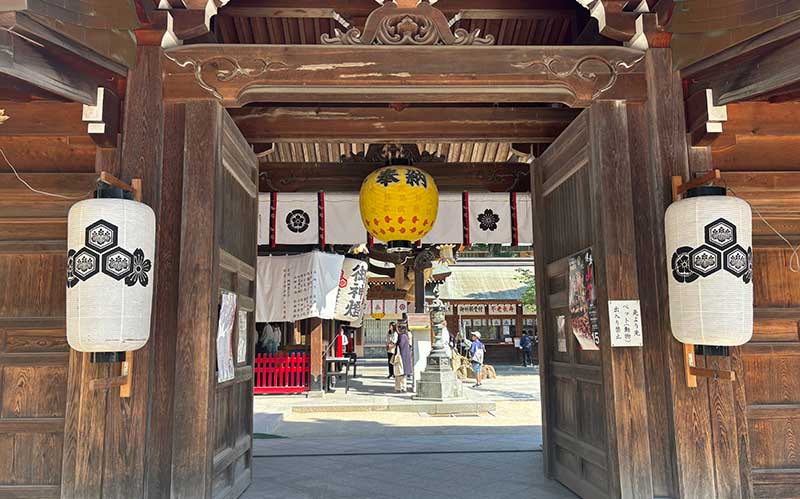
Kushida jinja shrine access
Address: 1-41 Kamikawabata-machi, Hakata-ku, Fukuoka City
tel:092-291-2951
Business hours: Opening hours: 4:00-22:00, business hours: 9:00-17:00
Official Website:Click here
Kushida jinja shrine is an important shrine where the history and traditions of Hakata are still alive and deeply inspiring to visitors. Experience the rich culture of Fukuoka through its beautiful shrine grounds and fascinating festivals and events. Next, let’s take a closer look at the Fukuoka Asian Art Museum.
D.Fukuoka Asian Art Museum Contemporary art in the heart of Tenjin
Fukuoka Asian Art Museum is located in the Across Fukuoka Building in Tenjin, Chuo-ku, Fukuoka City. Its location in the center of Tenjin makes access very convenient.

Required Time
To tour the museum at your leisure, you should allow two to three hours. If there are special exhibitions being held, we recommend allowing more time.

Highlights of Permanent and Special Exhibits
1.Asia Gallery
This gallery exhibits contemporary art works from Asian countries. The gallery brings together diverse Asian cultures and arts from Japan, China, Korea, and Southeast Asian countries. Visitors can enjoy various forms of expression such as paintings, sculptures, and installations.
2.Interaction Gallery
The works of artists who have stayed at the museum under the museum’s artist-in-residence program are on display. This is a valuable section where visitors can get a real-time sense of the contemporary Asian art scene.
3.Special Exhibits
Special exhibitions are held periodically at the Fukuoka Asian Art Museum. In the past, exhibitions have been held on a variety of themes, such as “Contemporary Art from Asia,” “Traditional Crafts from Southeast Asia,” and “Asian Pop Art. Special exhibitions are limited to a certain period of time, and visitors are sure to discover something new each time they visit.
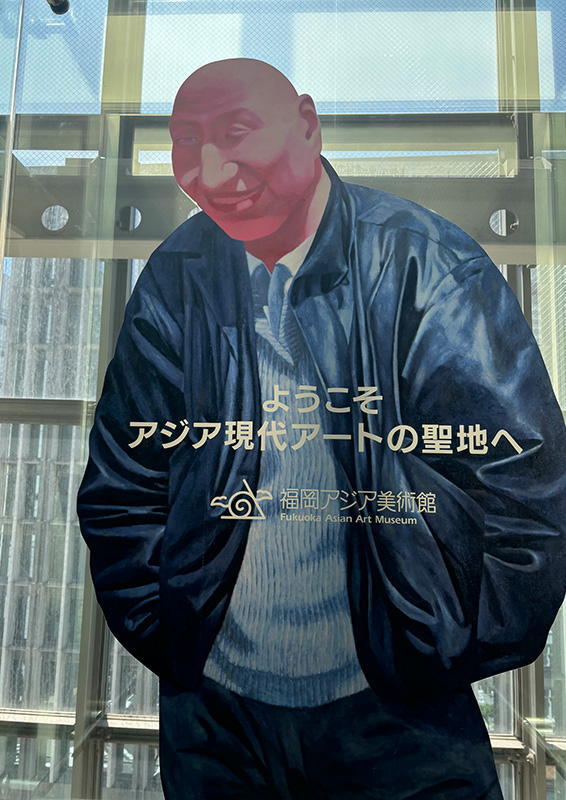
Museum architecture and its attractions
The Fukuoka Asian Art Museum building itself is another highlight of the museum. Located in the ACROS Fukuoka Building, it combines contemporary design with functionality.
Architectural Features
1.Modern design
The museum building features a contemporary design with extensive use of glass and steel frames. The exterior is stylish, while the interior offers spacious exhibition space.
2.Open Spaces
The interior of the museum has an open space design and is bright with natural light. The large windows also offer a view of the Tenjin cityscape.
3.Part of ACROS Fukuoka Building
The museum is located on the upper floors of the ACROS Fukuoka Building, which also houses shopping and dining facilities. It is recommended to use other facilities in the building before or after visiting the museum.
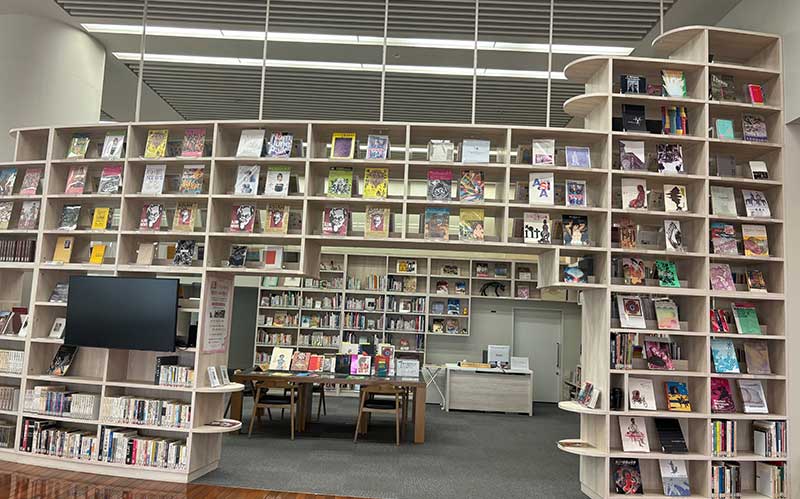
Museum Attractions
1.International Perspectives
The Fukuoka Asian Art Museum offers an international perspective by introducing art from various Asian countries. Contemporary art works, set against the backdrop of Asia’s diverse cultures and history, provide visitors with new perspectives.
2.A Place to Exchange and Learn
The museum regularly hosts exchange events, workshops, and lectures with artists and curators. This gives visitors the opportunity to learn and interact through art.
Fukuoka Asian Art Museum Access
Address: Riverain Center Building 7/8F, 3-1 Shimokawabatamachi, Hakata-ku, Fukuoka City, Fukuoka
Tel:092-263-1100
Hours: 9:30 – 18:00 (until 20:00 on Fridays and Saturdays) *Gallery entry until 30 minutes before closing
Hours: 9:30 – 19:30 (open until 20:00 on Fridays and Saturdays)
Transportation: ・Subway – Fukuoka City Subway Airport Line “Tenjin Station”, 5 min. walk, Subway Nanakuma Line “Tenjin Minami Station”, 5 min. walk
Bus – 5-minute walk from Tenjin Bus Center
– Car – Parking is available at the ACROS Fukuoka Building, but parking in the surrounding area is also available.
Official WebsiteClick here
The Fukuoka Asian Art Museum is a fascinating place to experience the diversity of culture and history through contemporary Asian art. Along with the museum’s stunning architecture, spend time enjoying the wealth of exhibits and gain a deeper understanding of Fukuoka City’s culture. Next, let’s take a closer look at the Fukuoka City Red Brick Cultural Museum.

E.Fukuoka Akarenga Bunka Kan, the cultural center– Important cultural property designed by Kingo Tatsuno
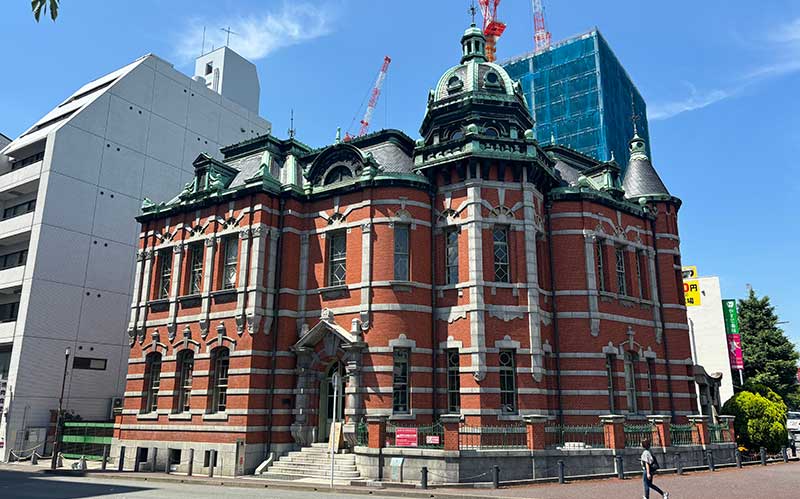
History of Fukuoka Akarenga Bunka Kan, the cultural center
The Fukuoka City Red Brick Cultural Center is a historical building completed in 1909, and was constructed as the former Fukuoka Prefecture Public Hall of Honor. It was designed by Kingo Tatsuno and Yasushi Kataoka, two of Japan’s leading architects. The duo is also known for their work on Tokyo Station and the Bank of Japan’s head office. The building was used as a library for a time after the war, but is now a popular cultural facility, and in 1981 it was designated an Important Cultural Property of Japan, recognizing its historical value.
Architecture by Kingo Tatsuno and Yasushi Kataoka
Kingo Tatsuno’s Achievements and Influence
Kingo Tatsuno (1854-1919), known as the father of modern architecture in Japan, is best known for his work on some of the country’s most iconic buildings, including Tokyo Station and the Bank of Japan’s headquarters. Kingo Tatsuno’s designs were influenced by the British Victorian Gothic style and are characterized by a combination of red brick and white stone. The Fukuoka City Red Brick Cultural Hall also follows this style, harmonizing the massive red brick with the elegance of the stone. Kingo Tatsuno’s achievements extend not only to architecture but also to education. As a professor of architecture in the Faculty of Engineering at Tokyo Imperial University (now the University of Tokyo), he trained many younger students. His influence was immeasurable, and he contributed greatly to the development of modern architecture in Japan.
Role and cooperation of Yasushi Kataoka
Yasushi Kataoka (1862-1913) was a student of Kingo Tatsuno and together they worked on many architectural projects. Yasushi Kataoka was also an important architect who contributed to the development of modern architecture in Japan, and together with Tatsuno designed the Fukuoka City Red Brick Cultural Center. Yasushi Kataoka’s design style was influenced by his mentor Tatsuno, but added his own unique sensibility. His delicate design and precise construction techniques can be seen throughout the Fukuoka City Red Brick Cultural Center. Kataoka’s talent is especially evident in the interior decoration and detailing.

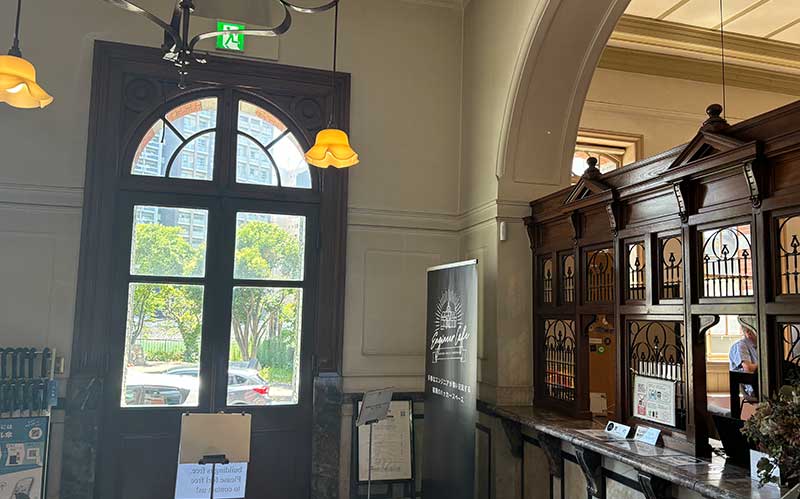
Architectural Features and Design Attraction
As the joint work of Kingo Tatsuno and Yasushi Kataoka, the Fukuoka City Red Brick Cultural Center is the culmination of their architectural philosophy. The building’s design has the following features and attractions
1.Harmony of red brick and white stone
The building’s exterior makes a strong impression on the viewer with its beautiful contrast of red brick and white stone. This design was influenced by the Victorian Gothic style, an English style in which Tatsuno excels.
2.Decorative facade
The front of the building is decorated with decorative arches, columns, and window frames, giving it a delicate and elegant appearance. These decorations reflect Kataoka Yasushi’s design sense.
3.High ceilings and wide spaces
The interior features high ceilings and wide spaces, creating a sense of openness. Large windows let in natural light, providing a bright and comfortable environment.
4.Attention to details
The staircase, railings, doorknobs, and other details are finely decorated. These details are areas where Kataoka Yasushi’s meticulous design can be felt.
The Fukuoka City Red Brick Cultural Center is a building of great historical and artistic value, the result of the collaboration of Kingo Tatsuno and Yasushi Kataoka. Its design, which combines beauty and functionality, continues to impress visitors. A visit to this building will allow visitors to appreciate the fascination of modern Japanese architecture and the achievements of these two architects.
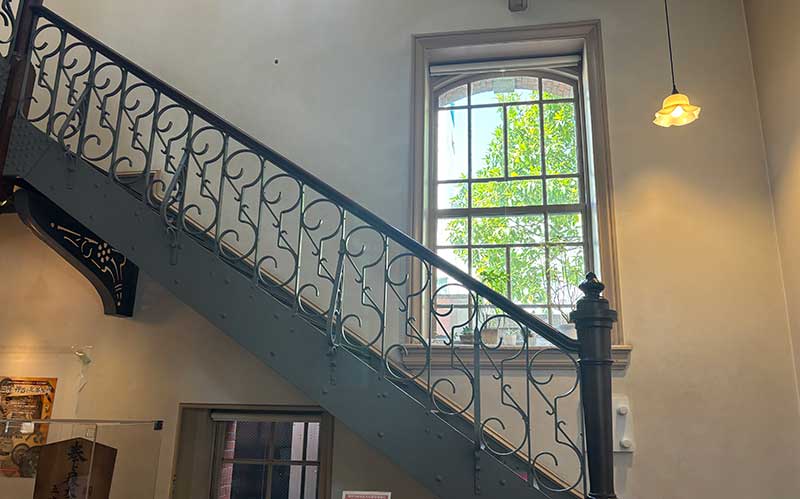
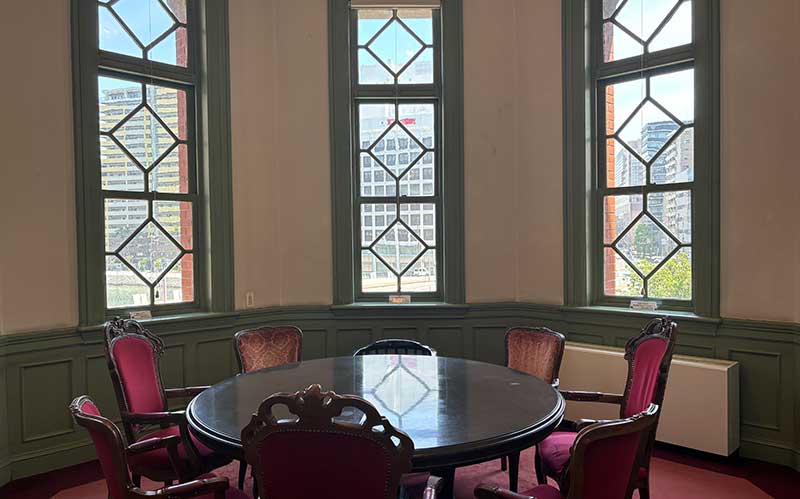
Fukuoka Akarenga Bunka Kan, the cultural center Access
Address: 1-15-30, Tenjin, Chuo-ku, Fukuoka City
Tel:092-722-4666
Hours: 9:00 – 22:00
Closed: Last Monday of each month (or the following weekday if the Monday is a national holiday), year-end and New Year holidays (December 29 – January 3)
Official Website:Click here
The Fukuoka Akarenga Bunka Kan, the cultural center is loved by many people through its historical value, beautiful architecture, and extensive exhibitions and events. Along with the surrounding scenery, visitors will have a wonderful time experiencing Fukuoka’s rich culture. Next, let’s take a look at the details of the former Fukuoka Kihinkan.

F.Guided tours of the former Fukuoka Kihinkan are recommended.
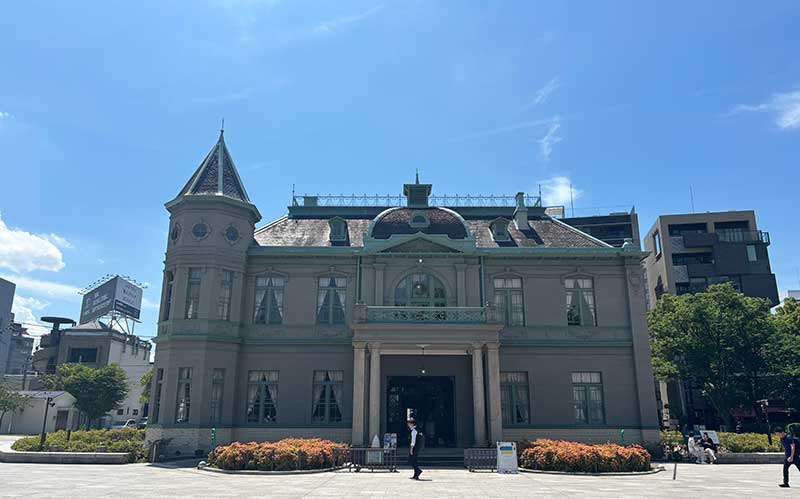
History and Role of Fukuoka Kihinkan
Fukuoka Kihinkan was built in 1910 as a guest house for Fukuoka Prefecture. It was designed by Cho-ichi Yoshitake, a pupil of Kingo Tatsuno. Built as a symbol of Japan’s modernization during the Meiji and Taisho periods, the Kihinkan served as an important facility for welcoming distinguished guests from Japan and abroad.
Fukuoka was an international trading port at the time and was visited by many foreigners and government officials, and the Kihinkan was built to host such dignitaries, where lavish banquets and conferences were held. After the war, the guest house continued to be used as an important guest house for Fukuoka Prefecture, and is now open to the public as a historical building.
Building Highlights
Fukuoka Kihinkan is noted for its luxurious architecture and delicate décor.
1.Exterior Decorations
The exterior of the building is designed in the Western architectural style of the Meiji period, with brickwork and white stone forming a beautiful contrast. It features a magnificent entrance porch and large windows, and is both stately and elegant.
2.Interior Decorations
The interior is beautifully decorated in every detail. The chandeliers, stained glass windows, and luxurious furniture have been preserved as they were in their original state, giving visitors a sense of the weight of history. The ceiling paintings and wall decorations in the Great Hall are especially worth seeing.
3.Banquet or reception hall
The Great Hall, located in the center of Kihinkan, is spacious and lavishly decorated. A large chandelier shines in the room, creating a prestigious atmosphere. Many important meetings and banquets have been held here.

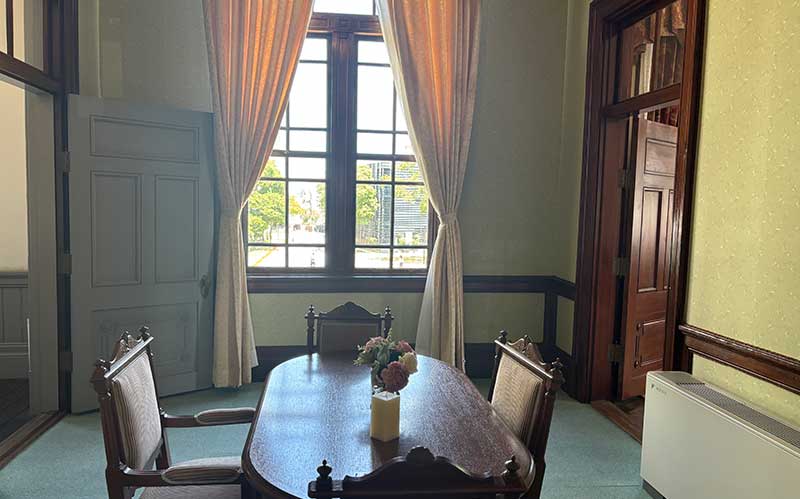

Public Events and Guided Tours Information
Kihinkan offers a variety of public events and guided tours.
Public Events
1.Historical Exhibits
Exhibits on the history and architecture of the Kihinkan are regularly presented. Through documents, photographs, and models, visitors can learn about the history of the guesthouse and its role.
2.Music concerts and performances
Classical music concerts and performances are held in the luxurious great hall. Visitors can enjoy a special time combining beautiful music and the atmosphere of the historic building.
Guided Tour Information
1.Regular Guided Tour
Guided tours are offered periodically, and professional guides provide detailed explanations of the history and architectural highlights of the noble residence. Reservations may be required to participate in the tours, so please check in advance.
2.Special Tours
Special tours are sometimes offered on a seasonal basis. For example, there are a variety of programs that include tours of the highlights of the gardens and tours with commentary to accompany special exhibitions.
Fukuoka Kihinkan Access
Address: 6-29 Nishinakasu, Chuo-ku, Fukuoka City, Fukuoka Prefecture
tel:092-751-4416(Fukuoka Prefectural Board of Education)
Hours: 9:00-17:00
Closed: Mondays (or the following day if Monday is a national holiday), December 29 – January 3
Official WebsiteClick here
Fukuoka Kihinkan is a treasured institution for its historical value, beautiful architecture, and charming gardens. Through public events and guided tours, visitors can experience the charm of this place more deeply. Next, let’s take a closer look at the Fukuhaku Deai Bridge.
G.Fukuhaku Deai Bridge Bridge connecting two towns
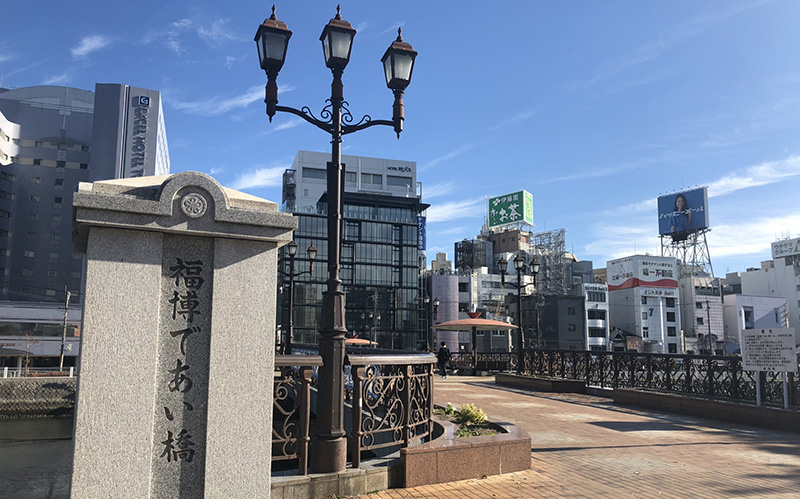
Introduction and History of Fukuhaku Deai Bridge
The Fukuhaku Deai Bridge is a pedestrian-only bridge over the Naka River in Chuo-ku, Fukuoka City, and is a symbolic link between Hakata and Fukuoka. The bridge opened in 1995 and has become a new landmark of Fukuoka City. The name “Deai Bridge” symbolizes the bridge’s role as a place where the people of Hakata (the former name of Fukuoka City) and Fukuoka, two towns separated by a river, can meet and deepen exchanges.
The design of the bridge is simple yet sophisticated, and creates a fantastic atmosphere at night when the entire bridge is beautifully illuminated. It also serves as a very convenient walking route for tourists and locals alike, as it connects the Tenjin and Nakasu districts on both sides of the river.
View from the bridge and photo spots
The view from Fukuhaku Deai Bridge is one of the most spectacular spots in Fukuoka City.
1.Panoramic view of the river and the city
From the bridge, visitors can enjoy a panoramic view of the city spread out on both banks of the Naka River as it flows by. Especially at dusk, the setting sun reflected on the surface of the river and the cityscape blend together beautifully, creating a romantic view.
2.Night view
At night, the bridge is illuminated and the reflection of the lights on the Naka River creates a fantastic atmosphere. Furthermore, the lights of the surrounding buildings and neon lights combine to create a colorful night view of Fukuoka. This beautiful night view is a popular photo spot for tourists with cameras.
3.Photo Spot
In the center of the bridge, there is a spot for taking commemorative photos, where you can enjoy a panoramic view of Naka River and Fukuoka City in the background. Visitors can enjoy different views at different times of the day, from bright daytime, to magic hour in the evening, to the night view, making it a place you will want to visit again and again.
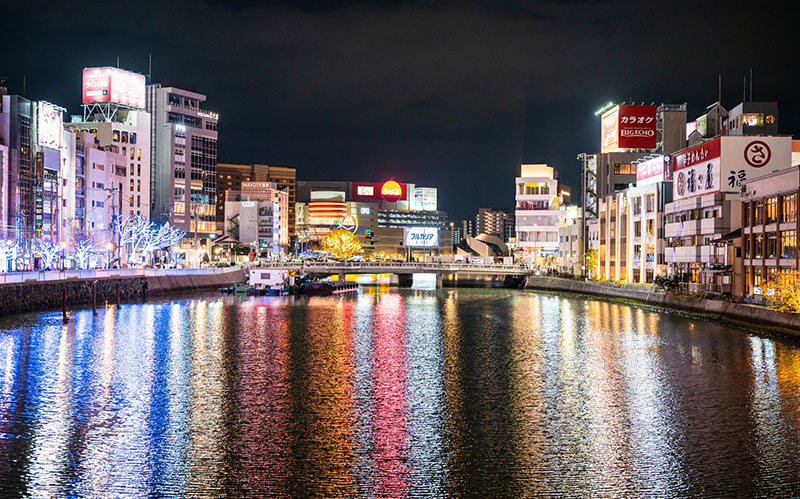
Strolling along the riverside in Hakata
This 78.2-meter-long pedestrian-only bridge over the Hakata River opened in 2011. From the bridge, visitors can enjoy views of the Hakata cityscape and the Port of Hakata. It is especially romantic at night when it is illuminated, making it a popular date spot.
Fukuhaku Deai Bridge Access
Address: Nishinakasu, Chuo-ku, Fukuoka City
Opening hours: 24 hours passage
Fukuhaku Deai Bridge is an attractive bridge because of its beautiful scenery, convenient location, and abundant walking spots in the surrounding area. Through the view from the bridge and a stroll along the river, visitors can fully enjoy the attractions of Fukuoka City. Now back to Gion Station.
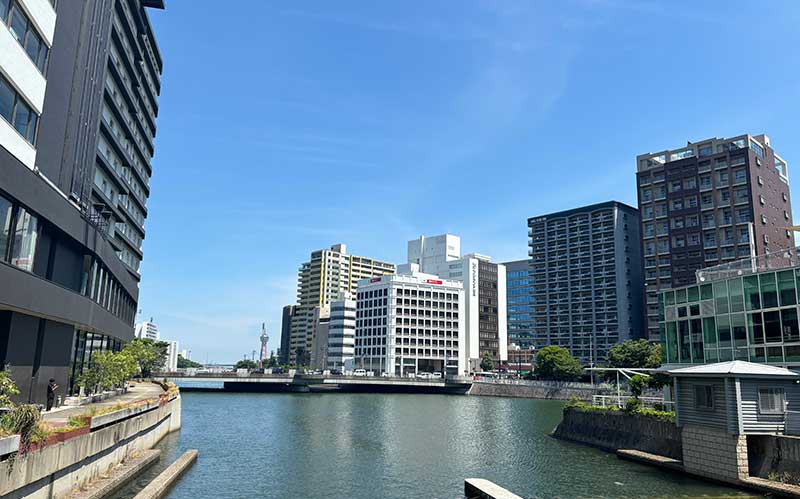
H.Gion Station
Back to Gion Station, where we started, and the end of today’s walk. Thank you for your hard work.
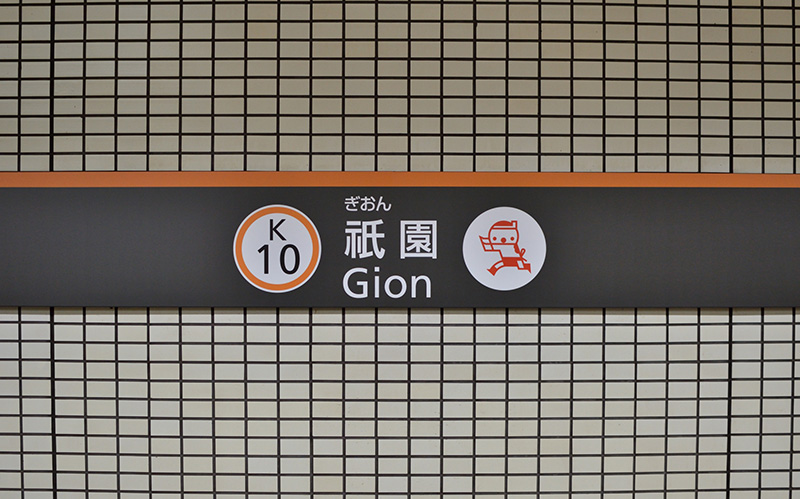
Fukuoka Stroll A review of a fun walk around Gion Station in Hakata
A.Gion Station Start
↓ 300m
B.Hakata Machiya Furusato Kan
↓ 50m
C.Kushida Jinja Shrine
↓ 450m
D.Fukuoka Asian Art Museum
↓ 550m
E.Fukuoka Akarenga Bunka Kan, the cultural center
↓ 350m
F.Fukuoka Kihinkan
↓ 150m
G.Fukuhaku Deai Bridge
↓ 1Km
H.Gion Station Goal
